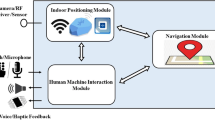Abstract
Locating a target in an indoor social environment with a Mobile Network is important and difficult for location-based applications and services such as targeted advertisements, geosocial networking and emergency services. A number of radio-based solutions have been proposed. However, these solutions, more or less, require a special infrastructure or extensive pre-training of a site survey. Since people habitually carry their mobile devices with them, the opportunity using a large amount of crowd-sourced data on human behavior to design an indoor localization system is rapidly advancing. In this study, we first confirm the existence of crowd behavior and the fact that it can be recognized using location-based wireless mobility information. On this basis, we design “Locating in Crowdsourcing-based DataSpace” (LiCS) algorithm, which is based on sensing and analyzing wireless information. The process of LiCS is crowdsourcing-based. We implement the prototype system of LiCS. Experimental results show that LiCS achieves comparable location accuracy to previous approaches even without any special hardware.







Similar content being viewed by others
Notes
A “special infrastructure” means that the infrastructure consists of customized equipment. LiCS is based on Received Signal Strength (RSS) that exists in any wireless equipment, so LiCS can be directly supported by existing wireless infrastructures around us.
For a location-aware online social network, if B is in the friend list of A, we consider that there is friendship between A and B, and the relationship is directed.
An Expectation-Maximization (EM) clustering algorithm [7] is used in this article. The EM assigns a probability distribution for each trace record (instance), which indicates the probability of each instance belonging to each of the clusters. The EM can automatically decide how many clusters to create.
The collected data with anonymous mobile devices from Brightkite is used to correlate, model, evaluate and analyze the relationships between the check-in time, locations, friendship and crowd behavior of users in 772,966 distinct places. The data consists of 58,228 nodes (users) and 214,078 friend edges (friendship is directed between any two nodes).
Even if the dataset is incomplete, it still can be used to show that “the impact of attributes (friendship and check-in locations) is existent on crowd behavior”.
A triple can be denoted as [R S S,M A C T ,M A C R ]. For the specific RSS of a location, M A C T is the MAC address of corresponding signal transmitter and M A C R is the MAC address of corresponding signal receiver.
In machine learning, using the hidden layer enables greater processing power and system flexibility. The nodes of hidden layer are named as hidden nodes. Hidden nodes are the nodes that are neither in the input layer nor the output layer. These nodes are essentially hidden from view, and their number and organization can typically be treated as a black box to people who are interfacing with the system.
Cumulative Distribution Function describes the probability that a real-valued random variable X with a given probability distribution will be found at a value less than or equal to x. It can be formulated as F X (x)=P(X≤x).
References
Bahl P, Padmanabhan VN (2000) Radar: an in-building rf-based user location and tracking system. In: Proceedings of the 19th annual international conference on computer communications (INFOCOM). IEEE, pp. 775–784
Borriello G, Liu A, Offer T, Palistrant C, Sharp R (2005) Walrus: wireless acoustic location with room-level resolution using ultrasound. In: Proceedings of the 3rd International Conference on Mobile systems, Applications, and Services (MobiSys). ACM, pp. 191–203
Chen M, Gonzalez S, Vasilakos A, Cao H, Leung VC (2011) Body area networks: a survey. Mob Netw Appl 16(2):171–193
Chen Y, Lymberopoulos D, Liu J, Priyantha B (2012) Fm-based indoor localization. In: Proceedings of the 10th international conference on mobile systems, applications, and services (MobiSys). ACM, pp 169–182
Cho E, Myers SA, Leskovec J (2011) Friendship and mobility: user movement in location-based social networks. In: Proceedings of the 17th international conference on knowledge discovery and data mining (SIGKDD). ACM, pp 1082–1090
Dey A, Hightower J, de Lara E, Davies N (2010) Location-based services. Pervasive Comput 9(1):11–12
Do CB, Batzoglou S (2008) What is the expectation maximization algorithm? Nat Biotechnol 26(8):897–899
Gu Y, Lo A, Niemegeers I (2009) A survey of indoor positioning systems for wireless personal networks. IEEE Commun Surv Tutorials 11(1):13–32
Gupta A, Kalra A, Boston D, Borcea C (2009) Mobisoc: a middleware for mobile social computing applications. Mob Netw Appl 14(1):35–52
Gyȯrbíró N, Fábián Á, Hományi G (2009) An activity recognition system for mobile phones. Mob Netw Appl 14(1):82–91
Jung S, Lee CO, Han D (2011) Wi-fi fingerprint-based approaches following log-distance path loss model for indoor positioning. In: Proceedings of the 1st MTT-S international microwave workshop series on intelligent radio for future personal terminals. IEEE, pp 1–2
Kjærgaard MB, Wirz M, Roggen D, Troster G (2012) Mobile sensing of pedestrian flocks in indoor environments using wifi signals. In: IEEE international conference on pervasive computing and communications (PerCom). IEEE, pp 95–102
Rai A, Chintalapudi KK, Padmanabhan VN, Sen R (2012) Zee: zero-effort crowdsourcing for indoor localization. In: Proceedings of the 18th annual international conference on mobile computing and networking (MobiCom). ACM, pp 293–304
Roos T, Myllymaki P, Tirri H (2002) A statistical modeling approach to location estimation. IEEE Trans Mobile Comput 1(1):59–69
Savvides A, Han CC, Strivastava MB (2001) Dynamic fine-grained localization in ad-hoc networks of sensors. In: Proceedings of the 7th annual international conference on mobile computing and networking (MOBICOM). ACM, pp 166–179
Scott J, Dragovic B (2005) Audio location: accurate low-cost location sensing. Pervasive Comput 3468:1–18
Tang F, Guo S, Guo M, Li M, Wang Cl (2011) Towards context-aware ubiquitous transaction processing: a model and algorithm. In: IEEE international conference on communications (ICC). IEEE, pp 1–5
Varshney U, Vetter R (2002) Mobile commerce: framework, applications and networking support. Mobile Netw Appl 7(3):185–198
Wu K, Xiao J, Yi Y, Gao M, Ni LM (2012) Fila: fine-grained indoor localization. In: Proceedings of the 31st annual international conference on computer communications (INFOCOM). IEEE, pp 2210–2218
Yang Z, Wu C, Liu Y (2012) Locating in fingerprint space: wireless indoor localization with little human intervention. In: Proceedings of the 18th annual international conference on mobile computing and networking (MobiCom). ACM, pp 269–280
Youssef M, Agrawala A (2005) The horus wlan location determination system. In: Proceedings of the 3rd international conference on mobile systems, applications, and services (MobiSys). ACM, pp 205–218
Zhang D, Guo B, Yu Z (2011) The emergence of social and community intelligence. Computer 44(7):21–28
Acknowledgment
Lei Shu’s work is supported by the Guangdong University of Petrochemical Technology Internal Project (2012RC0106).
Author information
Authors and Affiliations
Corresponding author
Rights and permissions
About this article
Cite this article
Chen, Y., Shu, L., Ortiz, A.M. et al. Locating in Crowdsourcing-Based DataSpace: Wireless Indoor Localization without Special Devices. Mobile Netw Appl 19, 534–542 (2014). https://doi.org/10.1007/s11036-014-0517-8
Published:
Issue Date:
DOI: https://doi.org/10.1007/s11036-014-0517-8




